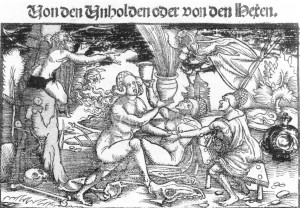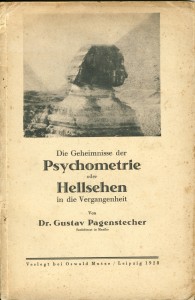Historical Anthropology
 Von der Unholden oder von den Hexen.
Von der Unholden oder von den Hexen.
From Johann Geiler von Kaysersberg, Emeis, 1517.
The non(?)- participant observer at the witches’ sabbat.
Historical anthropology
As is the case with social or cultural anthropology, there are many ways to define historical anthropology. I may review them one day; for the moment it suffices to state that I apply my own brand of critical anthropology on European history.
In the course of the 1990s, I wrote several pieces outside or at least on the margin of my then immediate interests of irregular healing and witchcraft. In the early 2000s I grouped them together under the label `historical anthropology’; in English they never made it beyond a book proposal but they did result in the werewolf project.
This proposal contained a chapter entitled: On the Margins of History. It was the only chapter that was never written. Here I can only offer the summary:
“Since the late 1960s historians have been engaged with anthropology to allow them a different perspective on history. Especially historical fields such as micro-history, history of popular culture and every-day life have sprouted from this interdisciplinary fertilization. But a critical stance is necessary. Too often anthropological concepts, especially those developed by Clifford Geertz and Mary Douglas, have been adopted by historians without taking into account the anthropological discussion. Moreover, anthropologists’ appropriation of the history of western society has often been focused on people and events on the margins.”
The other chapters can be found on this site in their original form in the sections on Irregular Healers and Sexuality, as well as below.
– Geloof, geweld en geschiedenis. Inleiding, Skript, historisch tijdschrift. (Themanummer Heilige overtuigingen: geschiedenis en geloof) 13 (1991): 197-202.
– Time and the Anthropologist; or the psychometry of historiography, Focaal 26/27 (1996): 17-24.
– `Schelm, hoer en kenaille’. Schelden in achttiende-eeuws Kolderveen, Volkskundig bulletin 18 (1992): 389-414. (themanummer Schimpen en schelden. Eer en belediging in Nederland, ca. 1600 – ca. 1800). [English version: Microhistory and the Study of Scolding]
– Katten, cultuur en context. Darntons Grote Kattenslachting opnieuw beschouwd, Feit & fictie. Tijdschrift voor de geschiedenis van de representatie 1.4 (1994): 101-113.
An earlier version of this article appeared as: Hoe antropologie gebruikt wordt in historisch onderzoek: Darntons `kattenslachting’ en de discussie daarover, in: Ritueel en symboliek in het dagelijks leven. Nederland 1500-1850. Werkboek. Heerlen: Open Universiteit (1992),167-209.
On Carlo Ginzburg:
– Spuren einer Volkskultur oder Dämonisierung? Kritische Bemerkungen zu Ginzburgs “Die Benandanti”, Kea. Zeitschrift für Kulturwissenschaft 5 (1993): 17-29.
Now I would also include our original introduction to Mediating Medicine:
– Who is Afraid of Constructionism?
Psychometry: the practice of particiating in the past.
(I have not analysed this particular book yet)
Cf. Time and the Anthropologist (1996)
Coda
The different strands on this site combine into an anthropological approach to history that is critical for contructs such as `folk culture’, `popular culture’, `medical history’ or `the human body’. This approach is essential to the understand, or at least attempting to, concepts such as werewolves, fairy tales, the witches’ sabbat or indeed shapeshifting in general. It also takes into account the issue of ethnographic authority (or the `perception of academic researchers’).
In my writings I try to rebuild historical images synchronically by paying attention to indigenous discourses, including both speech and stories, and processes of communication and misunderstanding, subsequently ordening them diachronically to reach an insight into distribution and matters of (dis-)continuity.
